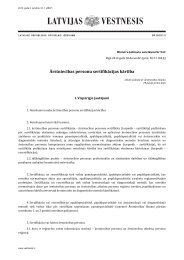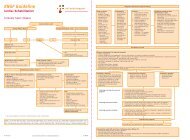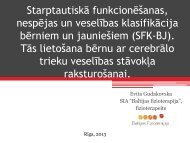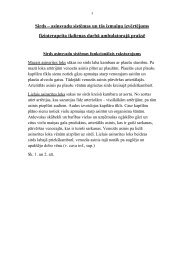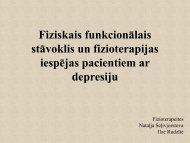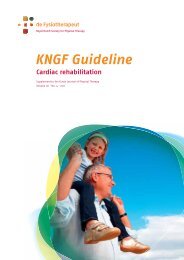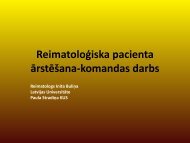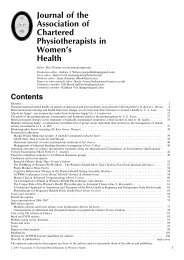Create successful ePaper yourself
Turn your PDF publications into a flip-book with our unique Google optimized e-Paper software.
A<br />
EXAMINATION – OUTCOME MEASURES<br />
<strong>Low</strong> <strong>Back</strong> <strong>Pain</strong>: Clinical Practice Guidelines<br />
Clinicians should use validated self-report questionnaires, such as<br />
the Oswestry Disability Index and the Roland-Morris Disability Questionnaire.<br />
These tools are useful for identifying a patient’s baseline<br />
status relative to pain, function, and disability and for monitoring a<br />
change in a patient’s status throughout the course of treatment.<br />
F<br />
EXAMINATION – ACTIVITY LIMITATION AND PARTICIPA-<br />
TION RESTRICTION MEASURES<br />
Clinicians should routinely assess activity limitation and participation<br />
restriction through validated performance-based measures. Changes<br />
in the patient’s level of activity limitation and participation restriction<br />
should be monitored with these same measures over the course of<br />
treatment.<br />
A<br />
INTERVENTIONS – MANUAL THERAPY<br />
Clinicians should consider utilizing thrust manipulative procedures to<br />
reduce pain and disability in patients with mobility deficits and acute<br />
low back and back-related buttock or thigh pain. Thrust manipulative<br />
and nonthrust mobilization procedures can also be used to improve<br />
spine and hip mobility and reduce pain and disability in patients with<br />
subacute and chronic low back and back-related lower extremity<br />
pain.<br />
A<br />
INTERVENTIONS – TRUNK COORDINATION,<br />
STRENGTHENING, AND ENDURANCE EXERCISES<br />
Clinicians should consider utilizing trunk coordination, strengthening,<br />
and endurance exercises to reduce low back pain and disability in patients<br />
with subacute and chronic low back pain with movement coordination<br />
impairments and in patients post–lumbar microdiscectomy.<br />
A<br />
INTERVENTIONS – CENTRALIZATION AND DIRECTIONAL<br />
PREFERENCE EXERCISES AND PROCEDURES<br />
Clinicians should consider utilizing repeated movements, exercises,<br />
or procedures to promote centralization to reduce symptoms in patients<br />
with acute low back pain with related (referred) lower extremity<br />
pain. Clinicians should consider using repeated exercises in a specific<br />
direction determined by treatment response to improve mobility<br />
and reduce symptoms in patients with acute, subacute, or chronic<br />
low back pain with mobility deficits.<br />
C<br />
INTERVENTIONS – FLEXION EXERCISES<br />
Clinicians can consider flexion exercises, combined with other interventions<br />
such as manual therapy, strengthening exercises, nerve<br />
a46 | april 2012 | volume 42 | number 4 | journal of orthopaedic & sports physical therapy<br />
mobilization procedures, and progressive walking, for reducing pain<br />
and disability in older patients with chronic low back pain with radiating<br />
pain.<br />
C<br />
INTERVENTIONS – LOWER-QUARTER NERVE<br />
MOBILIZATION PROCEDURES<br />
Clinicians should consider utilizing lower-quarter nerve mobilization<br />
procedures to reduce pain and disability in patients with subacute<br />
and chronic low back pain and radiating pain.<br />
D<br />
INTERVENTIONS – TRACTION<br />
There is conflicting evidence for the efficacy of intermittent lumbar<br />
traction for patients with low back pain. There is preliminary evidence<br />
that a subgroup of patients with signs of nerve root compression<br />
along with peripheralization of symptoms or a positive crossed<br />
straight leg raise will benefit from intermittent lumbar traction in the<br />
prone position. There is moderate evidence that clinicians should not<br />
utilize intermittent or static lumbar traction for reducing symptoms<br />
in patients with acute or subacute, nonradicular low back pain or in<br />
patients with chronic low back pain.<br />
B<br />
INTERVENTIONS – PATIENT EDUCATION AND<br />
COUNSELING<br />
Clinicians should not utilize patient education and counseling strategies<br />
that either directly or indirectly increase the perceived threat<br />
or fear associated with low back pain, such as education and counseling<br />
strategies that (1) promote extended bed-rest or (2) provide<br />
in-depth, pathoanatomical explanations for the specific cause of the<br />
patient’s low back pain. Patient education and counseling strategies<br />
for patients with low back pain should emphasize (1) the promotion<br />
of the understanding of the anatomical/structural strength inherent<br />
in the human spine, (2) the neuroscience that explains pain perception,<br />
(3) the overall favorable prognosis of low back pain, (4) the use<br />
of active pain coping strategies that decrease fear and catastrophizing,<br />
(5) the early resumption of normal or vocational activities, even<br />
when still experiencing pain, and (6) the importance of improvement<br />
in activity levels, not just pain relief.<br />
A<br />
INTERVENTIONS – PROGRESSIVE ENDURANCE EXERCISE<br />
AND FITNESS ACTIVITIES<br />
Clinicians should consider (1) moderate- to high-intensity exercise<br />
for patients with chronic low back pain without generalized pain, and<br />
(2) incorporating progressive, low-intensity, submaximal fitness and<br />
endurance activities into the pain management and health promotion<br />
strategies for patients with chronic low back pain with generalized pain.



